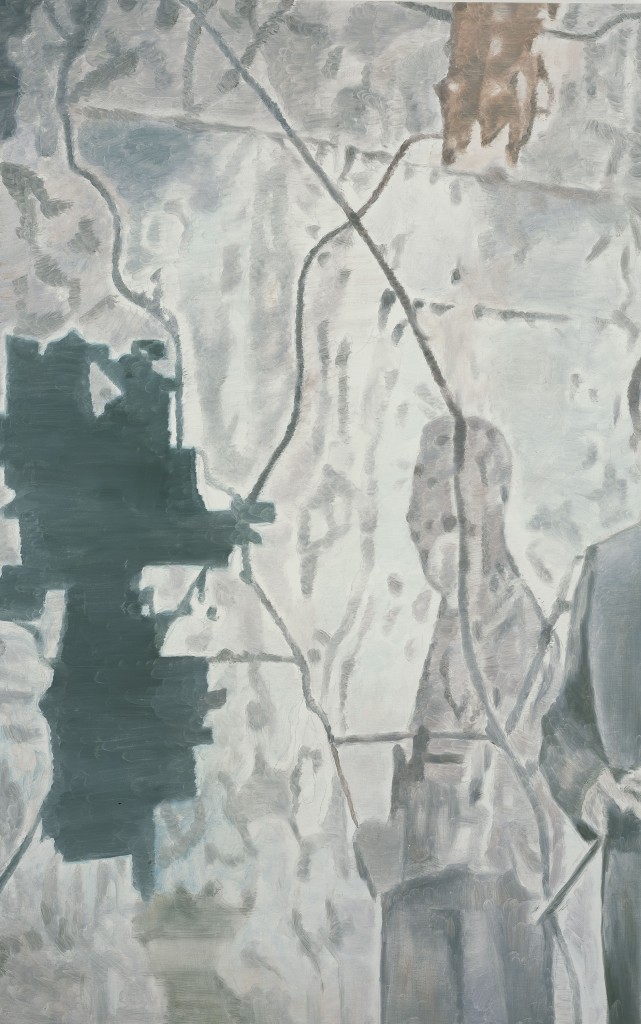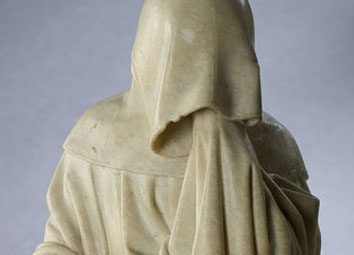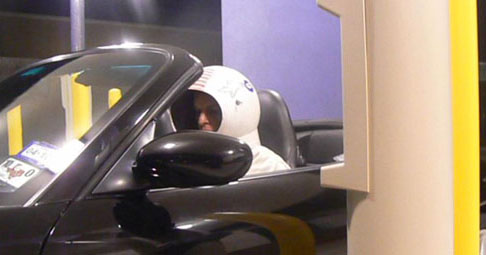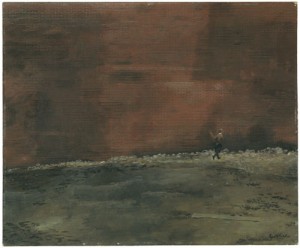To review the year’s visual art offerings and happenings, I chatted with FrontRow’s visual arts critics Noah Simblist, Rebecca Carter, and Lucia Simek to see what shows and exhibitions stuck out in 2010. Part one primarily discussed work in commercial galleries, while the second part touches on museums and non-profit spaces. (Click for part one.)
Noah Simblist: Well now that we’re begun to move out of commercial galleries, I think Jeffrey Grove’s re-installation of the Dallas Museum of Art’s contemporary collection is brilliant. I didn’t know that the museum had things like a large Jess, Wallace Berman, Bruce Connor or Carl Andre text pieces. The Luc Tuymans was also a very smart show put together by Helen Molesworth and Madeleine Grynsztejn, two of the best curators working today. I’m also happy to see that the Nasher has started to branch out to younger artists like Alyson Shotz. The Modern Art Museum Ft Worth had an interesting show by Gabriel Acevedo Velarde, bringing double helpings of both internationalism and contemporary conceptualism as well as the late Warhol show, which I found to be unresolved, but interesting to think about in terms of his enormous influence.

“Floor Corner Wall” at Ft Worth Contemporary showed the Rachofsky Collection in a completely new light, taking the rarefied objects that usually exist only in the context of a Richard Meyer house or a Edward Larrabee Barnes museum back into a relatively raw space that was probably more like the environment of the artists’ studios in which they were made. While the show at the Ft Worth Contemporary wasn’t fantastic, the Liam Gillick presence in Ft Worth with his lectures at the MAMFW and TCU, was an amazing experience.
As an organizer and/or participant, Modern Ruin, Three Propositions and a Musical Scenario and Eve Sussman at the Ft. Worth Contemporary, MAMFW and Meadows were all things that I was very proud of so I have to mention them but it’s probably too much of a conflict of interest to include in this discussion – thanks for the props Rebecca! In my memory, your show with Thomas at 500X was one of the best things this year but I just checked the dates and it was Dec 2009.
While the Contemporary was in transition in 2010, I’m very hopeful for what 2011 will look like under Peter Doroshenko. His plans for a show with Elaine Sturtevant, an 82 year old video artist who has never had a major show in the US seems to be the right direction to me. I mean check this out. I’m also looking forward to shows by M and Sterling Allen at the Ft Worth Contemporary.
Lucia Simek: I have yet to walk through Jeffrey’s show at the DMA (I hope to this afternoon), but I do hear it is quite good. And I like what I hear from him about bringing up a lot of the museum’s collection and putting it into the rotation in the barrel vault and the donor galleries. It’s a good way of keeping things fresh without a lot of fanfare, which is often best.

I was very taken by Heather MacDonald’s installation of The Mourners, which I found quite beautiful. Allowing the statues to be witnessed in open air conveyed a sense of trust in the general public on the part of the museum, and I appreciated that. Also, as historical shows go, this one seemed very lucid – not too tangled in “befores” and “afters” that muck up facts and make looking at the art less visceral. The collective hush in the Mourners gallery was a strong indication of the design’s curatorial intelligence.
And while I thought that the Nasher sold itself a little short with both the Jaume Plensa and the James Magee shows, I think it ended the year on a very strong note, with both Alyson Shotz’s installation and the Calder exhibit. I think that the Nasher has so much to offer by way of introducing a wide audience to good, challenging and imaginative programming, and I think it’s beginning to come into its own in that regard.

As far as other art happenings, Modern Ruin should surely be crowned as a huge victory/landmark for the Dallas art scene. What Christina and Thomas put together at that bank, and the way it all sort of unfolded naturally in the course of those few days it was open — the building coming to real ruin — was really sort of remarkable. I don’t think any one that had a part in making Modern Ruin could have suspected the tremor it would cause, and the layered interactions with the space that came about. My favorite thing was how visitors made impromptu sculptures with beer bottles in Cam Schoeppe’s leak buckets — the public went in there with a latent sense of entitlement to the space which forced additional wreckage on the building. It was genius. I hope very much that more things like it happen soon.
Sustenance, the show which took place in an abandoned warehouse on Singleton, curated by Anne Lawrence and Stephen Lapthisophon, was also a very good thing, though the show as a whole was shaky (but shakiness is surely a part of things when you throw a bunch of artists in a really gross building and tell them to go hog wild. I mean, the building itself was literally shaky). Ludwig Swartz‘s installation of a booted ghost, and Linnea Glatt and Jim Cinquemani’s outdoor watermelon circle were some of the best things I saw all year. Like Modern Ruin, this show brought with it a sense of the overflow of good ideas among artists in DFW.
I was also very excited to see the college show at 500X. While I thought the show as much too big, I was excited by what I saw in it, and pleased that 500X is bringing young art students to the fore. I think the show’s attention to college kids will be very important in keeping talent in the area. Dallas really needs some serious whippersnappers to stick around and make his place rock (harder).
Peter Simek: You have all said everything I was going to say: Mourners, Grove’s reuse of the barrel vault, Sightings at the Nasher. All very exciting.

One thing no one has touched on, though: we shouldn’t forget the Amon Carter. I thought their overall year was very strong, perhaps stronger than any other large local arts institution in light of the fact that they had no real weak shows in the mix. The shear volume of photography exhibitions began to create a kind of larger dialogue between the shows — a macro-exhibition, if you will (though you probably won’t) — and American Moderns on Paper was among my favorite shows of the year. Also, credit must go to Constructive Spirit: Abstract Art in South and North America for taking a selection of art that would otherwise cause my eyeballs to roll into the back of my head with boredom, and instead reconsidered its stature in the context of a greater history in a fascinating way. Not sure if any other single museum show in Dallas did quite that.
Noah is being polite by not talking about the Meadows and the Prado, which is a partnership I hope continues to flourish. The question for the museum though, as I flip through the Meadows’ site and see images advertising El Greco’s Pentecost and “Sultans and Saints: Spain’s Confluence of Cultures” topped by a rather drab rendering of the new George W. Bush Presidential Center, is which legacy will define what could become one of the premiere university museums in the nation: politics or the Prado?
Also, an honorable mention: Modern Twist: Bamboo Works from the Clark Center and the Art of Motoko Maio at the Crow Collection. Who knew baskets could be so moving?
Rebecca Carter: Yes to most of the above, and a few other thoughts: The exhibition of Rachel Whiteread drawings at the Nasher was quite satisfying. I loved seeing the process/thinking works. I am hopeful about the renewed vitality that seems to be emerging at the Nasher with the contemporary art and music programming.

Small and not necessarily earth shattering, the room of Jacob Lawrence prints at the DMA gave me new insight into Lawrence as a truly great American artist who continued to evolve his practice throughout his life. I enjoyed the exposition of African Masks at the DMA with its variety and intensity. I love that the DMA Center for Creative Connections gave a venue for Jill Foley to continue to install/create her large scale immersive work, creating an opportunity to opening up the space for participation with viewers both individually and in groups.
PS: I almost mentioned African Masks too, largely because of the thoughtfulness of the installation, which – like the Mourners – was so strong. This offers a positive note to end the year on: the DMA is building a reputation for playing loosey-goosy with its approach to exhibitions, and while something like Coastlines would make, in my opinion, a “worst of” list, The Mourners, African Masks, and Grove’s efforts offer evidence that the open environment being fostered at Dallas’ museum can work to some really wonderful effects. Likewise the Nasher, while none of their shows this year make it into my “top ten,” so to speak, more important is statement this year made about how the institution considers its role both in the Dallas conversation, but almost more importantly, in national and international conversations as well. Here’s where the Arts District really starts to work as a concept: the DMA and the Nasher offer two different approaches to thinking about the museum, but they both show a desire to continue to re-think about the museum. Having two institutions like that literally steps from each other will surely help enliven the conversation between them for years to come.
Image at top: Ellsworth Kelly at the Amon Carter Museum




